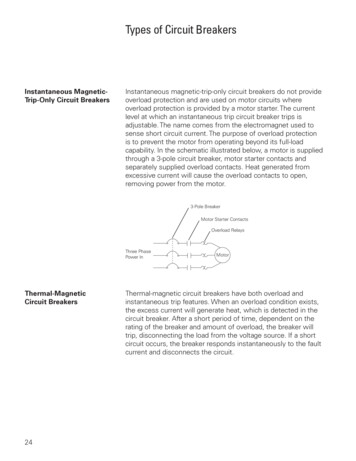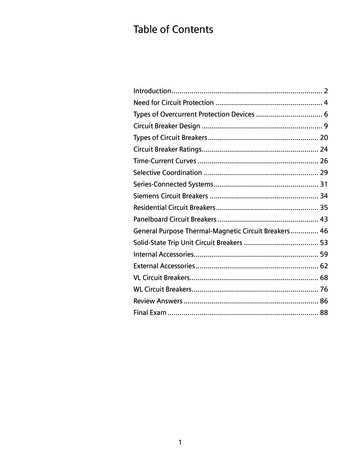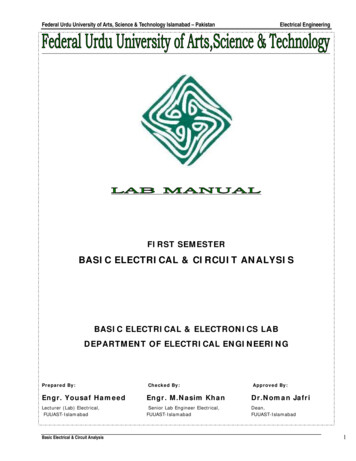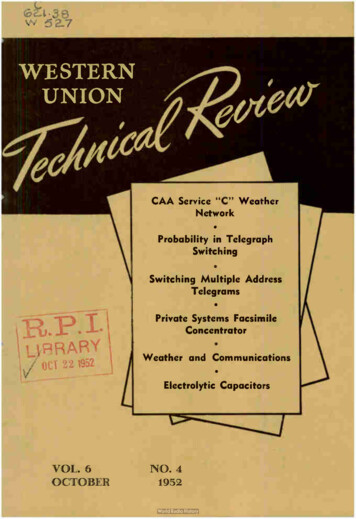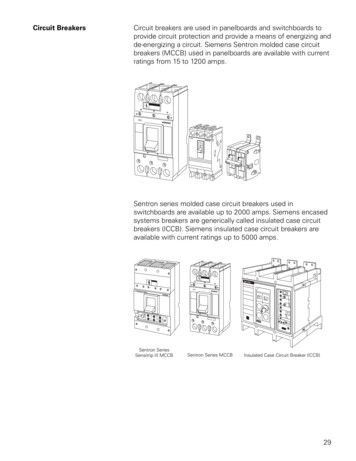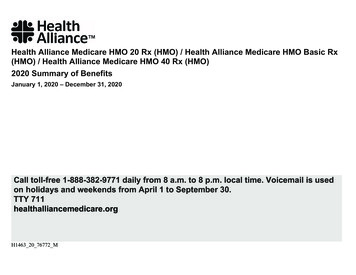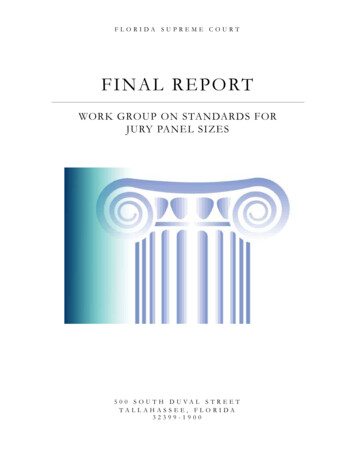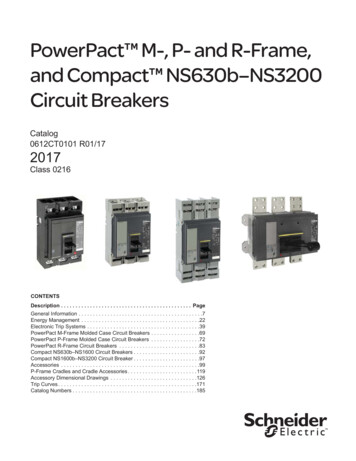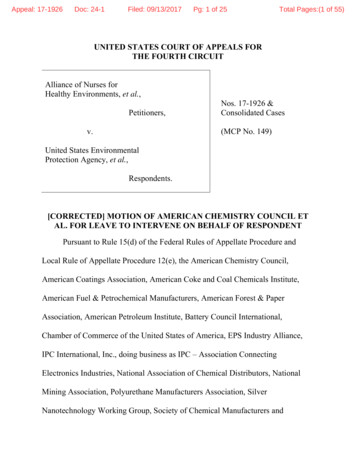
Transcription
Appeal: 17-1926Doc: 24-1Filed: 09/13/2017Pg: 1 of 25Total Pages:(1 of 55)UNITED STATES COURT OF APPEALS FORTHE FOURTH CIRCUITAlliance of Nurses forHealthy Environments, et al.,Petitioners,Nos. 17-1926 &Consolidated Cases(MCP No. 149)v.United States EnvironmentalProtection Agency, et al.,Respondents.[CORRECTED] MOTION OF AMERICAN CHEMISTRY COUNCIL ETAL. FOR LEAVE TO INTERVENE ON BEHALF OF RESPONDENTPursuant to Rule 15(d) of the Federal Rules of Appellate Procedure andLocal Rule of Appellate Procedure 12(e), the American Chemistry Council,American Coatings Association, American Coke and Coal Chemicals Institute,American Fuel & Petrochemical Manufacturers, American Forest & PaperAssociation, American Petroleum Institute, Battery Council International,Chamber of Commerce of the United States of America, EPS Industry Alliance,IPC International, Inc., doing business as IPC – Association ConnectingElectronics Industries, National Association of Chemical Distributors, NationalMining Association, Polyurethane Manufacturers Association, SilverNanotechnology Working Group, Society of Chemical Manufacturers and
Appeal: 17-1926Doc: 24-1Filed: 09/13/2017Pg: 2 of 25Total Pages:(2 of 55)Affiliates, Styrene Information and Research Center, and the Utility Solid WasteActivities Group (collectively, “Movants”), by and through undersigned counsel,respectfully move to intervene in support of Respondents the U.S. EnvironmentalProtection Agency (“EPA”) and its Administrator in each of the petitions forreview consolidated under the lead case Alliance of Nurses for HealthyEnvironments, et al. v. EPA, No. 17-1926 (“Petitions”).These Petitions were originally filed in three separate courts of appeals andwere recently consolidated before this Court by the United States Judicial Panel onMultidistrict Litigation. Consolidation Order at 1, MCP 149 (Sept. 1, 2017) (Doc.No. 3). The consolidated Petitions seek review of the “Procedures for ChemicalRisk Evaluation Under the Amended Toxic Substances Control Act,” 82 Fed. Reg.33,726 (July 20, 2017); 40 C.F.R. § 23.5(a) (“Risk Evaluation Rule”), a rulepromulgated by EPA under the Toxic Substances Control Act (“TSCA”), 15U.S.C. §§ 2601-2697, the primary federal statute that regulates the manufacturing,processing, distribution, and use of chemical substances and mixtures in the UnitedStates.Movants’ timely request to intervene in support of EPA’s final rule shouldbe granted. Movants are associations that represent industries directly regulatedand affected by the Risk Evaluation Rule, because they manufacture, process,distribute or use chemicals, and the procedures and criteria EPA has set in the Risk2
Appeal: 17-1926Doc: 24-1Filed: 09/13/2017Pg: 3 of 25Total Pages:(3 of 55)Evaluation Rule will ultimately affect what chemicals their members maymanufacture, process, transport and use, and under what restrictions, if any.Petitioners object to the approach EPA has taken and a ruling by this Court, thepractical effect of which would be expanding the chemicals and uses that would becovered and restricted by the risk evaluation process and otherwise negativelyaffecting the market prospects of existing chemicals. Hence, the consequences ofany relief Petitioners might obtain would be borne directly by Movants’ members,for whom chemicals regulated by TSCA are essential to the very conduct of theirbusinesses. As such, Movants have direct, substantial, and legally protectableinterests in the outcome of these consolidated petitions, which seek to overturn theRisk Evaluation Rule. These are interests that Respondents do not adequatelyrepresent.Counsel for Movants contacted counsel for the each of the Petitioners andfor Respondents in these consolidated cases. See Local Rule 27A. All of theparties responded that they take no position on the motion at this time.11Specifically, counsel for Respondents stated that “EPA will reserve taking aposition until after reviewing the potential intervenors’ motion.” Counsel forAlliance for Nurses for Healthy Environments, et al. stated that “Alliance ofNurses for Healthy Environments, Cape Fear River Watch, and Natural ResourcesDefense Council take no position on the motion at this time, but reserve their rightto oppose the motion based on its content.” Counsel for the EnvironmentalDefense Fund stated that “[t]he Environmental Defense Fund takes no position onthis motion at this time.”3
Appeal: 17-1926Doc: 24-1Filed: 09/13/2017Pg: 4 of 25Total Pages:(4 of 55)BACKGROUNDTSCA was amended in 2016 to require EPA to select a minimum number ofchemicals in commerce for risk evaluations. The amended statute requires EPA topromulgate three regulations to achieve its mandate, see 15 U.S.C. § 2605(b)(1),(4), all of which have now been promulgated. The first (known as the “InventoryReset Rule”2) sorts the master list of chemicals, called the TSCA Inventory, basedon whether the chemicals are active or inactive in commerce. The second (knownas the “Prioritization Rule”3) sets out procedures for the agency’s designation ofHigh Priority chemicals for purposes of risk evaluation. The third (the “RiskEvaluation Rule” at issue here) mandates a risk-based determination for theevaluated chemicals. Although these rules are separate, they are designed tofunction together; for example, the risk evaluation process cannot start untilchemicals are prioritized. Although only the Risk Evaluation Rule is at issue in theinstant matter, all three rules are described below for context to evaluate thisMotion.2TSCA Inventory Notification (Active- Inactive) Requirements, 82 Fed. Reg.37,520 (Aug. 11, 2017). Environmental Defense Fund has separately petitionedfor review of this rule. Envtl. Def. Fund v. EPA, No. 17-1201 (D.C. Cir.).3Procedures for Prioritization of Chemicals for Risk Evaluation Under the ToxicSubstances Control Act,” 82 Fed. Reg. 33,753 (July 20, 2017). Petitioners herehave separately petitioned to review this rule. See Safer Chemicals HealthyFamilies, et al. v. EPA, et al., No. 17-72260 and consolidated cases (9th Cir.)(MCP No. 148).4
Appeal: 17-1926Doc: 24-1Filed: 09/13/2017Pg: 5 of 25Total Pages:(5 of 55)Inventory Reset Rule. The Inventory Reset Rule establishes the proceduresEPA will follow to “reset” the TSCA chemical inventory. Only chemicals listedon the TSCA inventory are legal for use in the United States. Under the new rule,EPA has directed chemical manufacturers to identify the chemicals theymanufacture that are currently in commerce. If a chemical is not identified asactive, it will be listed as “inactive.” Only active chemicals would be subject toprioritization and, potentially, EPA’s risk review procedures.Prioritization Rule. The Prioritization Rule establishes the procedures andcriteria EPA will use to designate “High-Priority Substances” for risk evaluation,or “Low-Priority Substances” for which risk evaluations are not necessary untilsuch time as determined by the Administrator. This Rule “describes the processesfor formally initiating the prioritization process on a selected [chemical substance],providing opportunities for public comment, screening the [substance] againstcertain criteria, and proposing and finalizing designations of priority.” 82 Fed.Reg. at 33,753. The Prioritization Rule also clarifies EPA’s authority to determinewhat “conditions of use”4 of a chemical are appropriate for risk evaluation.4“[C]onditions of use” is a term of art, see 15 U.S.C. § 2602(4) (the term “meansthe circumstances, as determined by the Administrator, under which a chemicalsubstance is intended, known, or reasonably foreseen to be manufactured,processed, distributed in commerce, used, or disposed of”) and is not the same asthe term “use.”5
Appeal: 17-1926Doc: 24-1Filed: 09/13/2017Pg: 6 of 25Total Pages:(6 of 55)Risk Evaluation Rule. A risk evaluation cannot occur until a chemical hasbeen designated High Priority. In its Risk Evaluation Rule, EPA establishes theprocedures and criteria it will use when conducting those risk evaluations todetermine whether a chemical substance presents an unreasonable risk of injury tohealth or the environment under the conditions of use for that chemical. The RiskEvaluation Rule specifies procedures for the following steps of the risk evaluationprocess that must be followed: scoping, hazard assessment, exposure assessment,risk characterization, and finally a risk determination. Subsequent riskmanagement action may result in new requirements being placed on the use of achemical based on the risk determination. EPA has further elaborated on the riskassessment in guidance.The Movants are associations that represent industries and members that theRisk Evaluation Rule directly regulates and affects, because they manufacture,process, distribute or use chemicals that will be affected by the Risk EvaluationRule and the related Prioritization Rule. These include: Movant American Chemistry Council (“ACC”). ACC represents adiverse set of nearly 150 leading companies engaged in the business ofchemistry, including by participating on behalf of its members inadministrative proceedings before EPA and in litigation arising fromthose proceedings that affects member company interests. The businessof chemistry is a 797 billion enterprise and a key element of the nation’seconomy. Movant American Coatings Association (“ACA”) is the nationalnonprofit trade association working to advance the paint and coatings6
Appeal: 17-1926Doc: 24-1Filed: 09/13/2017Pg: 7 of 25Total Pages:(7 of 55)industry and the 287,000 professionals who work in it. The organizationrepresents paint and coatings manufacturers, raw materials suppliers,distributors, and technical professionals who produce over 30 billion inpaint and coating product shipments. ACA members use and producechemicals subject to regulation under TSCA, including the Prioritizationand Risk Evaluation Rules. Movant American Coke and Coal Chemicals Institute (“ACCCI”) is anassociation for the metallurgical coke and coal chemicals industry.ACCCI members include U.S. merchant coke producers and integratedsteel companies with coke production capacity, as well as the companiesproducing coal chemicals in the U.S. Coke and coals chemicals aresubject to regulation under TSCA, including the Prioritization and RiskEvaluation Rules. Movant American Fuel & Petrochemical Manufacturers (“AFPM”) is anational trade association whose members include over 400 refiners andpetrochemical manufacturers that produce gasoline, diesel, jet fuel, otherfuels and home heating oil, as well as the petrochemicals. AFPMmembers use and produce chemicals subject to regulation under TSCA,including the Prioritization and Risk Evaluation Rules. Movant American Forest & Paper Association (“AF&PA”) serves thesustainable pulp, paper, packaging, tissue and wood productsmanufacturing industry in the United States. AF&PA membercompanies make products essential for everyday life from renewable andrecyclable resources. The forest products industry accounts forapproximately four percent of the total United States manufacturingGross Domestic Product, manufactures over 200 billion in productsannually, and employs approximately 900,000 men and women.AF&PA’s members use chemical substances subject to TSCA tomanufacture or process their products, including chemicals subject to thePrioritization and Risk Evaluation Rules. Movant American Petroleum Institute (“API”) is a national tradeassociation representing all aspects of America’s oil and natural gasindustry. API has more than 625 members, from the largest major oilcompanies to the smallest of independents, from all segments of theindustry, including producers, refiners, suppliers, pipeline operators andmarine transporters, as well as service and supply companies that support7
Appeal: 17-1926Doc: 24-1Filed: 09/13/2017Pg: 8 of 25Total Pages:(8 of 55)all segments of industry. API’s members are involved in all major pointsof the chemical supply chain—from natural gas and crude oil production,to refinery production of fuels and other products, to service companiesusing chemicals. API’s members are affected by all of EPA’s activitiesunder TSCA, both directly as companies subject to regulation andindirectly as customers of regulated companies. API membersmanufacture and use chemicals subject to the Prioritization and RiskEvaluation Rules. Movant Battery Council International (“BCI”) promotes the interests ofthe battery industry whose members include lead battery manufacturersand recyclers, marketers and retailers, and suppliers of raw materials andequipment. Components used by the industry are subject to regulationunder TSCA, including the Prioritization and Risk Evaluation Rules. Movant Chamber of Commerce of the United States of America is theworld’s largest business federation. The Chamber represents 300,000direct members and indirectly represents the interests of more than threemillion companies and professional organizations of every size, in everyindustry sector, and from every region of the country. The Chamber’smembers include companies in all of the sectors covered by each of theother intervenors—chemicals, coatings, refiners, petrochemicals,petroleum, forestry, wood products, batteries, electronics, energy, andelectricity, among many others. These companies use chemicals subjectto regulation under TSCA, including the Prioritization and RiskEvaluation Rules. Movant EPS Industry Alliance represents manufacturers of expandedpolystyrene (“EPS”). EPS and the chemistries used to produce it aresubject to TSCA jurisdiction, including the Prioritization and RiskEvaluation Rules. Movant IPC International, Inc., doing business as IPC – AssociationConnecting Electronics Industries (“IPC”), is a not-for-profit associationconsisting of 4,200 member facilities that manufacture electronics orsupply equipment and materials to industries manufacturing electronics.The majority of IPC members use chemicals to manufacture products orsell products containing chemicals, but a small percentage manufactureand/or distribute chemicals to electronics manufacturers. Asmanufacturers, distributors and users of chemicals, IPC members are8
Appeal: 17-1926Doc: 24-1Filed: 09/13/2017Pg: 9 of 25Total Pages:(9 of 55)affected by TSCA rulemaking. The Risk Evaluation and PrioritizationRule proscribe the process under which the chemicals used by ourmembers will be regulated in the future. The development andmanufacture of electronics is directly affected by restrictions on thechemical used to manufacture them and thus effect IPC members. Movant National Association of Chemical Distributors (“NACD”) is anassociation of chemical distributors and their supply-chain partners.NACD’s members process, formulate, blend, repackage, warehouse,transport, and market chemical products for over 750,000 customers.The chemical distribution industry represented by NACD employs over70,000 people and generates 5.14 billion in tax revenue for localcommunities. The products distributed by NACD members are subject toEPA’s TSCA jurisdiction, including the Prioritization and RiskEvaluation Rules. Movant National Mining Association (“NMA”) is a national tradeassociation that represents the interests of the mining industry—includingthe producers of most of America’s coal, metals, and industrial, andagricultural minerals, as well as the manufacturers of mining and mineralprocessing machinery, equipment, and supplies—before Congress, theadministration, federal agencies, the judiciary, and the media. NMA hasmore than 300 members, many of which manufacture, process, and/oruse chemical substances subject to TSCA, including the Prioritizationand Risk Evaluation Rules. Movant Polyurethane Manufacturers Association (“PMA”) is theassociation dedicated to the advancement of the cast polyurethaneindustry. Its members include processors, suppliers and other membersin the cast urethane industry. The chemicals which are used tomanufacture polyurethanes are substances subject to EPA’s TSCAjurisdiction, including the Prioritization and Risk Evaluation Rules. Movant SOCMA – Society of Chemical Manufacturers and Affiliates(“SOCMA”) is the U.S.-based trade association dedicated solely to thespecialty chemical industry. SOCMA’s 200 members produceintermediates, specialty chemicals and ingredients used to develop a widerange of industrial, commercial and consumer products. SOCMA’smanufacturing members all produce chemicals subject to regulationunder TSCA that could be addressed by the Prioritization and Risk9
Appeal: 17-1926Doc: 24-1Filed: 09/13/2017Pg: 10 of 25Total Pages:(10 of 55)Evaluation Rules, and all of its members could be impacted by EPA’sactions under the rules. SOCMA was actively involved in the legislativeand rulemaking processes leading to issuance of the Prioritization Ruleand the Risk Evaluation Rule, filing comments on the proposed versionsof both. Movant Silver Nanotechnology Working Group (“SNWG”) is anindustry-wide effort to advance the science and public understanding ofthe beneficial uses of silver nanoparticles in a wide-range of consumerand industrial products. Silver nanotechnology is subject to EPA’sTSCA jurisdiction, including the Prioritization and Risk EvaluationRules. Movant Styrene Information and Research Center (“SIRC”) is anonprofit trade association that collects, develops, analyzes, andcommunicates information to guide industry and government on healthand environmental issues associated with styrene and ethylbenzene.Member companies manufacture or process styrene and ethylbenzene.Associate member companies fabricate styrene-based products. Styreneand ethylbenzene are chemical substances subject to TSCA, including thePrioritization and Risk Evaluation Rules. Movant Utility Solid Waste Activities Group (“USWAG”) is responsiblefor addressing solid and hazardous waste and chemical managementissues on behalf of the utility industry. USWAG was formed in 1978, andis a trade association of over 130 utility operating companies, energycompanies and industry associations. USWAG engages in regulatoryadvocacy pertaining to TSCA, among other policy areas. The industryuses substances subject to the requirements of TSCA, including thePrioritization and Risk Evaluation Rules.ARGUMENTI.Movants Satisfy the Standards for Intervention as of RightIn this Circuit, a court shall grant intervention as of right if an intervenormakes a timely motion and can show (1) an interest in the subject matter of theaction, (2) that the protection of this interest would be impaired by the disposition10
Appeal: 17-1926Doc: 24-1Filed: 09/13/2017Pg: 11 of 25Total Pages:(11 of 55)of this action, and (3) that the interest is not adequately represented by existingparties to the litigation. See Fed. R. Civ. P. 15(d); Fed. R. Civ. P. 24(a); In reSierra Club, 945 F.2d 776, 779 (4th Cir. 1991) (“must show interest, impairmentof interest, and inadequate representation”); Teague v. Bakker, 931 F.2d 259, 261(4th Cir. 1991) (citing Virginia v. Westinghouse Elec. Corp., 542 F.2d 214, 216(4th Cir. 1976)). These requirements should be interpreted broadly, as “liberalintervention is desirable to dispose of as much of a controversy involving as manyapparently concerned persons as is compatible with efficiency and due process.”Feller v. Brock, 802 F.2d 722, 729 (4th Cir. 1986).55Although this Court has not resolved the issue, a majority of the courts of appealhas correctly held that intervenors are not required to satisfy the requirements forArticle III standing, so long as they are not seeking additional relief and satisfy therequirements for intervention as of right under Rule 24(a). See e.g., King v.Governor of the State of New Jersey, 767 F. 3d 216, 246 (3d Cir. 2014) (partiesseeking to intervene as of right need not have independent standing so long asanother party with standing on the same side as the intervenor is in the case, citingcase law); accord Town of Chester v. Laroe Estates, 137 S. Ct. 1395 (2017)(requiring standing when intervenor sought relief different from plaintiff). But seeJones v. Prince George’s County, Maryland, 348 F. 3d 1014, 1017 (D.C. Cir.2003). This Court need not resolve the issue, because Movants have Article IIIstanding to intervene here. Movants’ members would have standing (as membersof the regulated community directly impacted by the rules at issue who stand to beinjured by this litigation), the subject of the litigation is germane to the Movants’interests, and no individual member’s participation is necessary for the litigation.See Declaration of Michael P. Walls (Attachment A) (“Walls Decl.”); Declarationof Jim McCloskey (Attachment B) (“McCloskey Decl.); Hunt v. Wash. State AppleAdvert. Comm’n, 432 U.S. 333 (1977).11
Appeal: 17-1926Doc: 24-1Filed: 09/13/2017Pg: 12 of 25Total Pages:(12 of 55)Here, Movants satisfy these requirements, and this Court should grant thisMotion so that they may protect their important interests.A.The Motion to Intervene is TimelyPetitioners in this consolidated case filed their petitions for review onAugust 10 and August 11, 2017. This motion is therefore timely because Movantsfiled within the time allotted by the Federal Rules. Fed. R. App. P. 15(d)(requiring parties to move for intervention within 30 days of the filing of a petitionfor review) and 26(a)(1) (when, as here, a deadline lands on a weekend, the filingis on the “next day that is not a Saturday, Sunday, or a legal holiday”). In addition,allowing Movants to intervene will not, as a practical matter, disrupt theproceedings or prejudice the parties because they are seeking to join this case at theearliest possible stage. Alt v. EPA, 758 F.3d 588, 591 (4th Cir. 2014) (timelinessbased on “how far the underlying suit has progressed” and whether the otherparties would suffer “prejudice”).B.Movants Have a Significant Protectable Interest in the Subject ofthe PetitionsThe Federal Rules do not define what “interest” is required to supportintervention of right. In the Fourth Circuit, for an interest to be “protectable,” itmust be a “significantly protectable interest.” Teague, 931 F. 2d at 261 (findingsignificant interest because the intervenors “stand to gain or lose” by outcome); seealso Sierra Club, 945 F.2d at 779 (environmental group had protectable interest in12
Appeal: 17-1926Doc: 24-1Filed: 09/13/2017Pg: 13 of 25Total Pages:(13 of 55)subject matter of waste management company’s challenge to state rule restrictingnew waste treatment, storage or disposal facility); United Guar. Residential Ins.Co. of Iowa v. Phila. Sav. Fund Soc’y, 819 F. 2d 473, 475 (4th Cir. 1987) (interestin insurance rights sufficiently significant).Here, unquestionably, Movants have a significantly protectable interest inthe subject matter of these consolidated Petitions. Movants’ membersmanufacture, process, distribute, or use chemicals that are essential to theirindustries and businesses and are subject to the Risk Evaluation Rule. See, e.g.,Walls Decl. ¶¶ 5. 20(a)-(p); McCloskey Decl. ¶¶ 4-5, 8. After determining thepriority of chemicals for evaluation, EPA will follow the process and criteria in theRisk Evaluation Rule for high priority chemicals to determine whether thechemical presents an unreasonable risk of harm to health or the environment underany foreseeable conditions of use, the result of which determination could lead torestrictions on such chemical’s use, up to and including a ban. These sameprocedures and criteria must be followed when manufacturers request an EPAconducted risk evaluation of any existing or new chemical substance.Accordingly, Movants potentially “stand to lose” access to chemicals thatare at the core of their operations, or to have that access restricted, depending uponthe results of EPA’s evaluations under the Risk Evaluation Rule. Likewise,Movants could lose millions of dollars and years of research invested in a13
Appeal: 17-1926Doc: 24-1Filed: 09/13/2017Pg: 14 of 25Total Pages:(14 of 55)chemical, if an EPA risk evaluation ultimately results in restrictions. Further,enormous uncertainty could be created if the Petitioners were to prevail and wouldaffect users’ confidence in planning new uses for existing substances. Thus, howEPA conducts these risk evaluations, including what conditions of use of aparticular chemical EPA must assess during these evaluations, are crucial toMovants. Movants have a direct interest in Petitioners’ challenge, which seeks tooverturn the process set by the Risk Evaluation Rule and expand the conditions ofuse that EPA would be required to consider in a risk evaluation.Movants have also demonstrated the significance of their direct andprotectable interest in the Risk Evaluation Rule by participating in the rulemakingthat culminated in the final rule.6 When a group seeking intervention hadparticipated “in the administrative process leading to the governmental action,” thegroup has a direct and substantial interest in the litigation. Michigan State AFLCIO v. Miller, 103 F.3d 1240, 1245-46 (6th Cir. 1997).In sum, Movants have the significant interest needed to intervene.6See, e.g., Walls Decl. at ¶ 13; McCloskey Decl. at ¶ 6. Other examples can befound at www.regulations.gov, docket number EPA–HQ–OPPT–2016–0654.14
Appeal: 17-1926C.Doc: 24-1Filed: 09/13/2017Pg: 15 of 25Total Pages:(15 of 55)The Disposition of These Consolidated Petitions Could Impair orImpede Movants’ Ability as a Practical Matter to Protect TheirSignificant Interests in the Risk Evaluation RuleFurther, resolution of these consolidated Petitions could impair or impedeMovants’ ability to protect their interests in the Risk Evaluation Rule. In thisCircuit, it is sufficient that a judgment “would impair or impede the Intervenors’ ability to protect their interest in the subject matter of th[e] litigation.”Teague, 931 F.2d at 261 (the intervenors’ significant interest in recovery would beimpaired even if still retained rights of action and potential effect was contingent inpart on other litigation); United Guar., 819 F. 2d at 475 (sufficient impairment ifdisposition of the pending case “might well” deprive the proposed intervenors of asignificant insurance benefit). Moreover, it is sufficient that the outcome could “asa practical matter” impair or impede the proposed intervenor’s interests in aseparate administrative proceeding. Sierra Club, 945 F.2d at 779 (if court were toenjoin certain sections of regulation, it “will impede Sierra Club’s ability to protectits interest in the administrative proceeding”).As detailed above, Movants’ members manufacture, process, distribute, useand otherwise rely on chemicals in the conduct of their businesses, and Petitionersseek a court order that would require EPA to change the process and criteriaestablished in the Risk Evaluation Rule to make the process more onerous forMovants in order to impose additional restrictions on how chemicals are15
Appeal: 17-1926Doc: 24-1Filed: 09/13/2017Pg: 16 of 25Total Pages:(16 of 55)manufactured, processed, distributed and used. Movants’ interests in sustainingtheir members’ operations could be impeded or impaired if the disposition of thisaction results in the changes in the Risk Evaluation Rule that Petitioners arepursuing here. Only if this Court allows Movants to participate in this action willMovants be able to protect fully their interests in the evaluation approach in theRisk Evaluation Rule.D.Existing Parties Do Not Adequately Represent Movants’ InterestsThe existing parties do not adequately represent Movants’ interests in thiscase. In general, the Supreme Court has held that a movant seeking to intervene asof right need only show that representation of its interests “may be” inadequate,and the burden of showing so is “minimal.” Trbovich v. United Mine Workers ofAm., 404 U.S. 528, 538 (1972); see Sierra Club, 945 F.2d at 779-80 (citingTrbovich for adequacy standard, emphasizing that this requirement is met ifapplicant shows “representation of its interest may be inadequate”) (emphasis inoriginal); Teague, 931 F.2d at 262 (citing Trbovich for adequacy standard); seealso United Guar., 819 F.2d at 475 (same). In Sierra Club, for example, this Courtfound an organization that supported the state agency’s defense of its regulationwas not adequately represented by the preexisting parties, because while the stateagency ostensibly represented “all of the citizens,” the organization represented“only a subset of citizens concerned” with the subject matter of the action and did16
Appeal: 17-1926Doc: 24-1Filed: 09/13/2017Pg: 17 of 25Total Pages:(17 of 55)“not need to consider the interest of all citizens.” 945 F.2d 780 (reversed denialof intervention as of right, even though interests of Sierra Club and state agency“may converge”). The same is true here. See also, Sierra Club v. EPA, 557 F.3d401 (6th Cir. 2009); Fund for Animals, Inc. v. Norton, 322 F.3d 728, 735 (D.C. Cir.2003); Military Toxics Project v. EPA, 146 F.3d 948, 954 (D.C. Cir. 1998);Conservation Law Found. of New England v. Mosbacher, 966 F.2d 39, 41-44 (1stCir. 1992). But see Stuart v. Huff, 706 F.3d 345, 351 (4th Cir. 2013).7Here, Movants are not represented at all by the Petitioners, who are directlyadverse to Movants. Nor do Respondents adequately represent Movants’ interests,as EPA does not represent the distinct private interests of Movants and theirmembers. Movants exist in part to ensure that the companies they represent areable to manufacture, process, distribute, or use chemicals as needed, and therebyoperate the nation’s manufacturing and energy facilities, preserve and create jobs,and produce successful businesses, all in an environmentally sound manner.7Stuart involved intervention in a district court case concerning theconstitutionality of a state statute where intervention could have significantlyincreased the burdens on the government and the court. Id. at 350-51 (“motions tointervene can have
IPC International, Inc., doing business as IPC - Association Connecting Electronics Industries, National Association of Chemical Distributors, National Mining Association, Polyurethane Manufacturers Association, Silver . Movants are associations that represent industries directly regulated and affected by the Risk Evaluation Rule, because .




